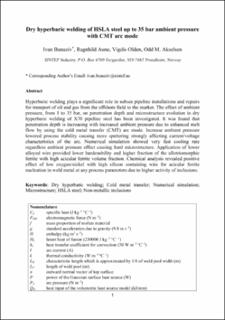| dc.contributor.author | Bunaziv, Ivan | |
| dc.contributor.author | Aune, Ragnhild | |
| dc.contributor.author | Olden, Vigdis | |
| dc.contributor.author | Akselsen, Odd Magne | |
| dc.date.accessioned | 2020-12-11T07:47:29Z | |
| dc.date.available | 2020-12-11T07:47:29Z | |
| dc.date.created | 2019-11-21T10:15:04Z | |
| dc.date.issued | 2019 | |
| dc.identifier.citation | The International Journal of Advanced Manufacturing Technology. 2019, 105 2659-2676. | en_US |
| dc.identifier.issn | 0268-3768 | |
| dc.identifier.uri | https://hdl.handle.net/11250/2717057 | |
| dc.description.abstract | Hyperbaric welding plays a significant role in subsea pipeline installations and repairs for transport of oil and gas from the offshore field to the market. The effect of ambient pressure, from 1 to 35 bar, on penetration depth and microstructure evolution in dry hyperbaric welding of X70 pipeline steel has been investigated. It was found that penetration depth is increasing with increased ambient pressure due to enhanced melt flow by using the cold metal transfer (CMT) arc mode. Increase ambient pressure lowered process stability causing more spattering strongly affecting current/voltage characteristics of the arc. Numerical simulation showed very fast cooling rate regardless ambient pressure effect causing hard microstructure. Application of lower alloyed wire provided lower hardenability and higher fraction of the allotriomorphic ferrite with high acicular ferrite volume fraction. Chemical analysis revealed positive effect of low oxygen/nickel with high silicon containing wire for acicular ferrite nucleation in weld metal at any process parameters due to higher activity of inclusions. | en_US |
| dc.language.iso | eng | en_US |
| dc.publisher | Springer | en_US |
| dc.subject | Hyperbaric welding | en_US |
| dc.subject | pipeline steel | en_US |
| dc.subject | Numerical simulation | en_US |
| dc.title | Dry hyperbaric welding of HSLA steel up to 35 bar ambient pressure with CMT arc mode | en_US |
| dc.type | Peer reviewed | en_US |
| dc.type | Journal article | en_US |
| dc.description.version | acceptedVersion | en_US |
| dc.rights.holder | Copyright © 2019, Springer-Verlag London Ltd., part of Springer Nature. This is the accepted, peer-reviewed version. The published article is available at SpringerLink https://link.springer.com/article/10.1007/s00170-019-04511-6#rightslink | en_US |
| dc.source.pagenumber | 2659-2676 | en_US |
| dc.source.volume | 105 | en_US |
| dc.source.journal | The International Journal of Advanced Manufacturing Technology | en_US |
| dc.identifier.doi | 10.1007/s00170-019-04511-6 | |
| dc.identifier.cristin | 1750269 | |
| dc.relation.project | Norges forskningsråd: 234110 | en_US |
| cristin.ispublished | true | |
| cristin.fulltext | postprint | |
| cristin.qualitycode | 2 | |
